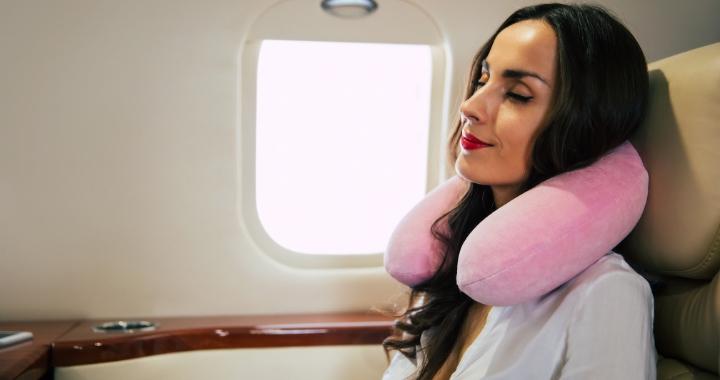If you’ve ever taken a long flight, you’re probably familiar with that overwhelming feeling of fatigue that often accompanies air travel. Feeling tired during air travel, often referred to as travel fatigue, is a common occurrence. There are several reasons why flying might make you tired, and understanding these factors can help you mitigate the effects and arrive at your destination feeling more refreshed.
In this post, we’ll delve into the causes of in-flight tiredness and provide tips on how to deal with it. Let’s dive right in!

Why Does Flying Make You Tired?
Changes in Oxygen Levels at Higher Altitudes
When you’re cruising at 30,000 feet or more, the oxygen levels in the cabin are significantly lower than at sea level. This decrease in oxygen can make you feel tired, especially if you’re not acclimated to high altitudes.
To combat this, try to breathe deeply and regularly, and consider using supplemental oxygen if necessary.
Fluctuations in Air Pressure
Air pressure inside the cabin is carefully regulated to simulate conditions at about 8,000 feet above sea level. This change in air pressure can affect your body’s ability to absorb oxygen efficiently, potentially leading to fatigue.
Staying hydrated and drinking lots of water can help alleviate this symptom.
Dry Air in the Cabin
The low humidity levels in the aircraft cabin can cause dehydration and contribute to feelings of tiredness.
To counteract this, drink plenty of water throughout your flight, and consider using a moisturizer to prevent dry skin.
Disruption of Circadian Rhythm
Crossing multiple time zones during long flights can lead to jet lag, a phenomenon where your internal body clock is out of sync with the local time at your destination. This misalignment can make you feel tired and groggy.
To minimize the effects of jet lag, adjust your sleep schedule before your trip to gradually align with your destination’s time zone.
Sleep Deprivation
On long flights, it can be challenging to get quality sleep, especially if you’re in a cramped economy seat. Lack of sleep is a surefire way to feel tired upon arrival.
To counter this, try to get some rest by using a travel pillow, an eye mask, and noise-canceling headphones. Even better? A comfortable and suitable Jetbed is a sure way to avoid sleep deprivation and arrive at your destination feeling refreshed and ready to tackle the day. Sleeping on a private jet, if you have the luxury, can make a significant difference.
Cabin Pressure Variations
During takeoff and landing, the cabin pressure undergoes noticeable changes. These fluctuations in air pressure can lead to feelings of discomfort and tiredness, especially if you have a cold or sinus congestion.
Chewing gum, swallowing, or using specialized earplugs designed for pressure changes can help alleviate this discomfort.
Elevation and Duration of Flight
The elevation of your destination airport and the duration of your flight can also impact how tired you feel upon arrival. If you’re flying to a city at a significantly higher altitude than your departure location, your body may need time to adjust to the thinner air, which can lead to fatigue.
Additionally, the longer the flight, the more likely you are to experience tiredness, so try to move around the cabin periodically and perform in-seat exercises to improve circulation.

Tips on How to Deal With In-flight Tiredness
1. Stay hydrated.
Dehydration can exacerbate feelings of tiredness due to the dry cabin air and changes in air pressure. Drink plenty of water throughout your flight to stay hydrated. Avoid excessive caffeine and alcohol, as they can contribute to dehydration.
2. Adjust your sleep schedule.
If you’re crossing multiple time zones, try to adjust your sleep schedule before your trip. Gradually shift your bedtime and waking time to align with your destination’s local time. This can help reduce the impact of jet lag.
3. Create a comfortable sleep environment.
Make your seat as comfortable as possible for sleep. Use a travel pillow, an eye mask, and noise-canceling headphones to block out disturbances. Reclining your seat, if possible, can also improve your sleep posture.
When flying private, pack your Jetbed with the highest quality linens and see how easy and comfortable sleeping on a flight can truly be.
4. Stay active.
Combat physical fatigue by moving around the cabin and performing in-seat exercises. Stretch your legs, flex your ankles, and rotate your shoulders to improve blood circulation. These simple exercises can prevent stiffness and discomfort.
5. Choose the right seat.
Selecting the right seat can make a significant difference in your comfort during the flight. If you prefer extra legroom, consider booking an exit row or premium seat. Window seats can provide a more comfortable place to rest your head.
6. Manage stress and anxiety.
Stress and anxiety can contribute to fatigue. Practice relaxation techniques like deep breathing or meditation to help calm your nerves. Consider bringing a stress-relief tool like a stress ball or soothing music to help you relax.
7. Limit screen time.
The blue light emitted by screens on electronic devices can interfere with your sleep quality. Consider limiting screen time before attempting to sleep, and enable night mode settings on your devices to reduce blue light exposure.
8. Stay consistent with your routine.
Maintain your usual routines as much as possible. If you typically read a book before bed or have a bedtime ritual, replicate it on the plane. Familiar habits can signal to your body that it’s time to sleep.

Understanding these causes of in-flight tiredness can help you take proactive measures to mitigate their effects.
Remember that each person’s body responds differently to long flights and in-flight tiredness. By proactively managing in-flight tiredness, you can enhance your travel experience and make the most of your time at your destination.
As you are cruising safely through the skies, ensure your jets are equipped with JetBed. The innovative product turns your jet seats into luxurious, comfortable beds for optimal in-air sleeping. It’s easy to use and lightweight, and with our large collection of options it fits almost every aircraft!
Remember to stay hydrated, adjust your sleep schedule when crossing time zones, and create a comfortable sleep environment when possible. By prioritizing self-care during air travel, you can arrive at your destination feeling more refreshed and less jet-lagged. Safe travels!

